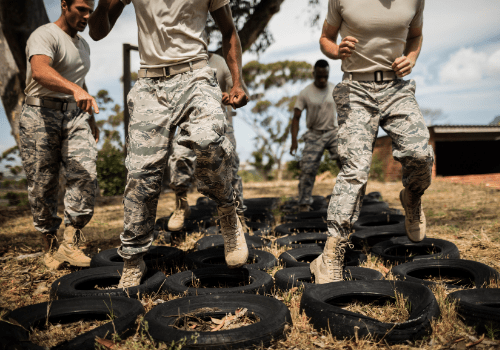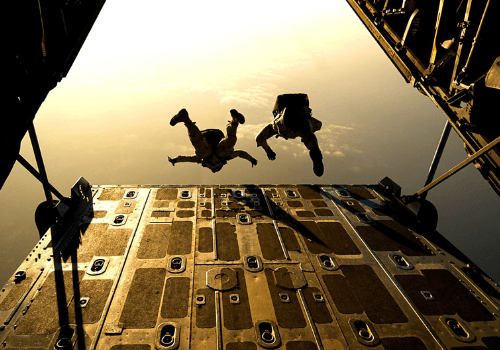What is Biometric Feedback?
Military professionals have quickly adopted biometric feedback into their daily lives to help conserve their energy and improve performance. Biometric feedback typically works by connecting electrical sensors to your body that read and receive information. In terms of military professionals, they can incorporate biosensors into their clothing to monitor their health or performance levels.
Biometric feedback is helping soldiers to better understand their body’s emotional, physiological, and physical states. If soldiers can better understand their body cues, they can respond appropriately to improve their overall performance levels.
Our team at Butler Technologies is a custom manufacturer of screen-printed biometric feedback sensors and electrodes. Standard biofeedback sensors include the following:
– Electrocardiograph (ECG/EKG) sensors for heart rate monitoring
– Electroencephalograph (EEG) sensors for monitoring brain activity
– Surface Electromyography (sEMG) sensors for monitoring muscle activity
– Electrical Muscle Stimulation (EMS or e-STIM) for treating/targeting muscle pain.
– Transcutaneous Electrical Nerve Stimulation (TENS) for targeting/treating nerve pain.
– Printed Sensors for monitoring respiratory rate.

In terms of biometric feedback for military personnel, each of these sensors can provide their own unique contribution to increasing their performance and help to monitor the soldier’s overall health.
Health Monitoring
As mentioned previously, biometric feedback can be both in terms of performance and health vitals. Electrocardiograph sensors, otherwise known as ECG or EKG sensors, work to monitor heart rate. The sensors monitor to ensure the heart isn’t overworking, and that there aren’t any abnormalities in the soldier’s heart rate.
Electroencephalograph, or EEG sensors for short, work to monitor brain activity. These EEG sensors can be incorporated into headgear often worn by soldiers to monitor brainwaves and any abnormalities in the electrical energy and activity in the brain. The electrodes can detect even the smallest charges that result from the brain’s activity. If any abnormalities are present, the sensors can relay that information via Bluetooth to a remote device at any given location.
Stress management is also crucial for soldiers to ensure their health and well-being. It is no secret that soldiers are typically in a frequent state of high-stress situations. But if the soldiers are in a constant state of stress, it could have a detrimental impact on their health. Sensors can be created for not only heart rate monitoring but also to monitor respiratory rate. By combining both of these sensors among soldiers, they could be adequately monitored to ensure they’re not in a constant state of stress or exposing themselves to symptoms of combat stress.
As a soldier’s heart rate and/or respiratory rate increase, the information can be relayed via Bluetooth to a smartphone or other device. Depending on the severity of the soldiers’ stress and the duration of time they have been in that state, they can take appropriate action to avoid any harmful or detrimental impacts on their health.
Performance Monitoring
Biometric feedback is essential to performance monitoring. Performance monitoring refers to being able to monitor muscle activity as well as your body’s overall performance. It can monitor for overexertion and help to establish an appropriate baseline for your body.
Especially for soldiers, being able to monitor muscle activity is crucial. Biometric feedback can help to monitor a soldier’s muscle performance for muscle symmetry and muscle fatigue. In other words, it can help to ensure that muscles are performing at the same level and one of them has not become overstrained. If one muscle is significantly outperforming the other, it would be a tell-tale sign that there may be an underlying reason, such as an injury.
Biosensors can also monitor for muscle fatigue to help avoid injuries before they occur. If a muscle is becoming severely overstrained or not performing to its full potential, a soldier can immediately become aware and take the appropriate downtime. This also helps to catch potential injuries early on, so they have the chance to avoid them or avoid making them any worse.

Establishing a soldier’s baseline is also vital. A baseline refers to monitoring a soldier’s vitals for an extended period and then using software to find that soldier’s averages. Biosensors can monitor player load, jumps, acceleration, speed, and distance traveled and then use that data to conclude what the soldier’s overall baseline is. The average found is considered their baseline, or where their body is most comfortable. Once a baseline has been determined, the soldier can be monitored for any abnormalities or spikes that may occur. A baseline can be established both in terms of the soldier’s health vitals, as well as their performance – such as where their body typically is during exertion. This provides soldiers a fair warning of any potential performance injuries or overexertion before it occurs and allows them the chance to take downtime to prevent it.
There are so many direct benefits to monitoring a soldier’s biometric feedback. It can help ensure their health and well-being while also helping avoid any serious injuries to their bodies. It helps them ensure they perform to the best of their ability without overexerting themselves or being put at risk of an injury. If you are interested in learning more or getting your next project started, reach out! Our team of experienced engineers are readily available to help you every step of the way.
 Meet the Author: Jaclyn King
Meet the Author: Jaclyn King
Jaclyn is a Marketing Communications Specialist on the BTI Team. She serves as the Content Manager, where she primarily manages social media channels, SEO, Public Relations, and website development. To get to know more about Jaclyn, check her out on LinkedIn!